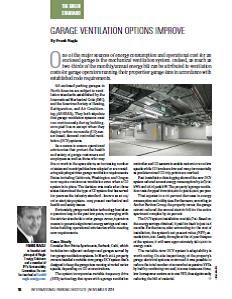One of the major sources of energy consumption and operational cost for an enclosed garage is the mechanical ventilation system. Indeed, as much as two-thirds of the monthly/annual energy bill can be attributed to ventilation costs for garage operators running their properties’ garage fans in accordance with established code requirements.
All enclosed parking garages in North America are subject to ventilation standards established by the International Mechanical Code (IMC) and the American Society of Heating, Refrigeration, and Air Conditioning (ASHRAE). They both stipulate that garage ventilation systems must run continuously during building-
occupied hours except when they deploy carbon monoxide (CO) sensor-based, demand-controlled ventilation (DCV) systems.
As a means to ensure operational efficiencies that protect the health and safety of garage customers and employees as well as those who may live or work in the space above, an increasing number of states and municipalities have adopted or are considering adopting stricter garage ventilation requirements. States including California, Washington, and Oregon now require continuous ventilation even when a CO system is in place. The decision was made after those states determined the type of CO system that has served for years as the industry standard—known as an on/off or start/stop system—may present mechanical and health and safety issues.
Fortunately, garage ventilation technology has taken a quantum leap in the past few years, converging with the stricter standards to offer garage owner/operators means to generate significant energy savings and maximize building operational efficiencies while meeting new requirements.
Case Study
Consider Parc Pointe Apartments, Burbank, Calif., which includes two adjacent underground garages served by two garage ventilation systems. In March 2013, property owners installed a variable-flow garage DCV system that’s designed to keep the garage fans running at varied motor speeds, depending on CO concentrations.
The system incorporates variable frequency drive (VFD) technology that syncs with a garage ventilation controller and CO sensors to enable motors to run at low speeds while CO levels are low and ramp incrementally as predetermined CO trip points are reached.
Post-installation data logging showed the new DCV system reduced annual energy consumption by 307,900 kWh and 35.15 peak kW. The property’s garage ventilation costs dropped from $48,000 to just $2,800 per year.
That equates to a 94 percent decrease in energy consumption and utility fees. Furthermore, according to Anchor Pacifica Group, the property owner, the garage retrofit reduced the annual electric bill for the entire apartment complex by 38 percent.
The DCV system installation cost $69,700. Based on the energy savings obtained, it paid for itself in just 18.5 months. Furthermore, after accounting for the cost of installation, the system’s net present value (NPV) exceeds $490,000. Lastly, throughout the 15-year lifespan of the system, it will save approximately $610,000 in energy costs.
The variable-flow DCV system’s adaptability is worth noting. On-site inspection(s) of the property’s garage electrical systems confirmed it was possible to reduce the total number of somewhat expensive VFDs by half by combining two and, in some instances three, low-horsepower motors on to one VFD, thus significantly reducing the bill of material.
Frank Nagle is founder and principal of Nagle Energy Solutions and a member of IPI’s Sustainability Committee. He can be reached at frank@nagle-energy.com.
TPP-2014-11-Garage Ventilation Options Improve

